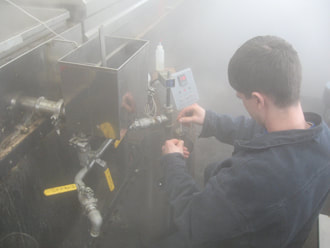The process begins by drilling a hole in a maple tree and inserting a spout. From the tree will flow sap which on average is 2% sugar. The sugaring season comes in the spring when warmer weather is on its way. Sap flow is caused when the temperature dips below freezing at night and is above freezing during the day. (As summer nears and the trees begin to bud, sugaring season is ended, the sap becomes bitter and cloudy at this point.)
The sap is collected from each individual tree with a bucker or at one central point by way of a pipeline system. Vacuum is applied to these systems to increase production. A sap production increase of two times is common with this method. The sap is then brought to the sugarhouse for boiling. The sap is fed into an evaporator, which is fired by either wood or oil, and the water is 'boiled' off to a sugar content of 66%.
Below are some pictures of when we started building our sugar house.
The sap is collected from each individual tree with a bucker or at one central point by way of a pipeline system. Vacuum is applied to these systems to increase production. A sap production increase of two times is common with this method. The sap is then brought to the sugarhouse for boiling. The sap is fed into an evaporator, which is fired by either wood or oil, and the water is 'boiled' off to a sugar content of 66%.
Below are some pictures of when we started building our sugar house.










